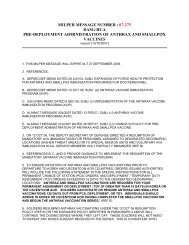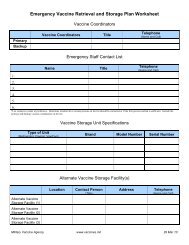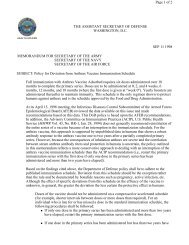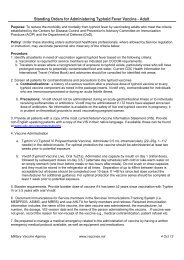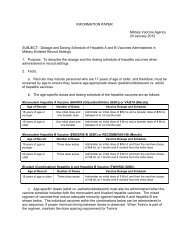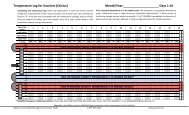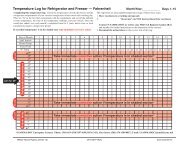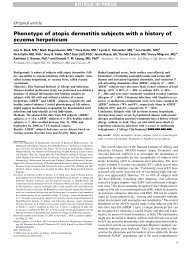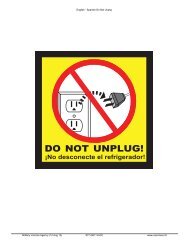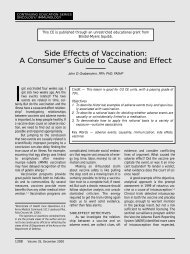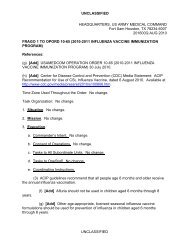Hurricane Preparedness: Emergency Vaccine Storage ... - MILVAX
Hurricane Preparedness: Emergency Vaccine Storage ... - MILVAX
Hurricane Preparedness: Emergency Vaccine Storage ... - MILVAX
You also want an ePaper? Increase the reach of your titles
YUMPU automatically turns print PDFs into web optimized ePapers that Google loves.
===============================================================<br />
<strong>Hurricane</strong> <strong>Preparedness</strong>: <strong>Emergency</strong> <strong>Vaccine</strong> <strong>Storage</strong> and Handling<br />
===============================================================<br />
Table of Contents:<br />
1. Checklist for Clinics without Backup Power<br />
2. Checklist for Clinics on Backup Power<br />
3. Resources for <strong>Emergency</strong> Procedures<br />
4. Packing Protocols for Moving <strong>Vaccine</strong><br />
5. Procedures for Reporting <strong>Vaccine</strong> Loss<br />
===============================================================<br />
1. Checklist for Clinics without Backup Power<br />
- Move all vaccine that is not stored in a location supported by back-up power to<br />
your the designated alternate site (i.e., logistics, pharmacy, alternate clinics)<br />
- When moving vaccine it must be packed and labeled correctly. Make sure it stays<br />
within the proper temp during transport and is placed in an appropriate<br />
refrigerator or freezer. Keep a detailed itemized list along with contact<br />
information affixed to outside of the transport box for easy identification. Box<br />
should be labeled as a "temperature sensitive" and "Refrigerated" or "Frozen"<br />
product.<br />
- If possible, decrease immunization operations today in order to have plenty of<br />
time to pack and move product. Determine a packing priority list for vaccine in<br />
case not all vaccine can be moved.<br />
- If no alternate storage site is available, immediately notify your regional<br />
analyst for assistance.<br />
2. Checklist for Clinics on Backup Power<br />
- Make sure all refrigerators and freezers within the clinic are clearly labeled<br />
on the outside of the unit.<br />
- Clinics with backup power must VERIFY functionality of all equipment<br />
-- Make sure refrigerator/freezer is plugged into the designated emergency power<br />
(normally the red outlets)<br />
-- Verify all alarm and call systems are plugged into emergency power or they<br />
will not be able to operate.<br />
-- If alarm or call system has a battery backup ensure system is charged or has<br />
new batteries<br />
-- Check the automated call system to determined if it is programmed correctly<br />
and calling the appropriate designated clinic staff<br />
-- TEST call and alarm system before departing clinic<br />
Military <strong>Vaccine</strong> Agency (877) GET-VACC www.vaccines.mil
- Verify duty officer alarm response procedures and policies are updated<br />
- Prepare supplies within the clinic for an emergency movement of vaccine.<br />
Validated containers, refrigerator packs, and thermometers, along with packing<br />
protocol for responders should be readily accessible.<br />
- Verify VaxiCool is fully charged and plugged into emergency power.<br />
- Verify VaxiPac phase change bricks are fully chilled according to instructions<br />
and that there are 3 bricks per VaxiPac. Do not use any other cooling item<br />
(frozen or refrigerated packs) with the Vaxipac.<br />
- Have <strong>Storage</strong> and Handling emergency plan readily accessible and review with all<br />
staff<br />
- All clinics in potentially low lying areas or in lower levels of the facility<br />
that may incur flooding should move vaccine to a higher level location.<br />
- Call continuous temperature tracking system (i.e., Sensaphone, REES) more<br />
frequently during the storm, if possible.<br />
3. Resources for <strong>Emergency</strong> Procedures<br />
<strong>Emergency</strong> <strong>Vaccine</strong> Retrieval and <strong>Storage</strong> Plan Worksheet: Local list of emergency<br />
contacts and equipment repair. Should be prepared as part of emergency standard<br />
operating procedures, updated as needed and readily accessible to all staff.<br />
<strong>Emergency</strong> Response Worksheet: Utilize when power failure has occurred to prepare<br />
and managed potentially compromised vaccine.<br />
Temperature logs: For tracking temperatures of vaccines both when stored in<br />
refrigerator, when transporting or storing off site.<br />
<strong>Vaccine</strong> <strong>Storage</strong> and Handling Guideline: A 40-page guide to assist clinics in day<br />
to day and emergency procedures. All above worksheets, packing procedures, and<br />
emergency procedures are outlined in the guide.<br />
http://www.vaccines.mil/documents/1437<strong>MILVAX</strong>_S&H_Guidelines_FullVer_8_Jul_11.pdf<br />
4. Packing Protocols for Moving <strong>Vaccine</strong><br />
All packing protocols are available from USAMMA<br />
http://www.usamma.army.mil/cold_chain_management.cfm<br />
<strong>Vaccine</strong> packing reminders:<br />
Military <strong>Vaccine</strong> Agency (877) GET-VACC www.vaccines.mil
- Always use validated containers (Endurotherm shipping containers, Styrofoam<br />
coolers with at least 2 in thick walls, Manufacturer shipping containers,<br />
Vaxipac, Vaxicool)<br />
- Always include calibrated thermometer to track temperatures during transport<br />
and storage<br />
- Always document vaccine type, date, time, originating facility, phone number<br />
and that the contents are fragile and temperature sensitive on the outside of<br />
transportation container<br />
- Always use insulating barrier (e.g., crumpled paper, bubble wrap) between cold<br />
packs and the vaccines. Never place vaccine directly on frozen packs.<br />
- Record temperatures hourly when vaccine is outside of a functioning<br />
refrigerator or freezer<br />
5. Procedures for Reporting <strong>Vaccine</strong> Loss<br />
Sometimes vaccine loss cannot be prevented. If vaccine is suspected to have been<br />
outside the safe temperature range immediate action must be taken.<br />
- Segregate and label potentially compromised vaccine as "DO NOT USE".<br />
Immediately place in a functioning storage unit, do not leave in malfunctioning<br />
refrigerator.<br />
- Record temperatures of refrigerators when vaccine discovered and length of time<br />
vaccine was potentially compromised.<br />
- Inventory all the vaccine affected, lot numbers and value and report through<br />
Service-specific channels, to USAMMA DOC and to your local <strong>MILVAX</strong> Regional<br />
Analyst.<br />
- Prepare and Executive Summary which describes the incident, temperatures,<br />
vaccine information and corrective action taken<br />
- NEVER discard vaccine until it has been confirmed as a loss by USAMMA<br />
USAMMA DOC is the DoD agency responsible for the managing and storage of<br />
temperature sensitive medical products. To contact USAMMA for vaccine loss<br />
guidance call: 301-619-4318/1187/4198 0700-1700 (EST)<br />
For after hours urgent issues: 301-676-1184/0857 or 301-256-8072<br />
Email: usammadoc@amedd.army.mil<br />
For more information and tools for vaccine storage and handling<br />
http://www.vaccines.mil/storageandhandling<br />
CDC <strong>Vaccine</strong> <strong>Storage</strong> and Handling<br />
http://www2a.cdc.gov/vaccines/ed/shtoolkit/default.htm<br />
Military <strong>Vaccine</strong> Agency (877) GET-VACC www.vaccines.mil
Military <strong>Vaccine</strong> Agency<br />
http://www.vaccines.mil<br />
http://www.smallpox.mil<br />
http://www.anthrax.mil<br />
(877)GET-VACC<br />
mailto:vaccines@amedd.army.mil<br />
Please feel free to pass this message on to your colleagues. To add or remove<br />
your name from this mailing list, please click here --<br />
http://www.vaccines.mil/ContactUs<br />
Military <strong>Vaccine</strong> Agency (877) GET-VACC www.vaccines.mil



